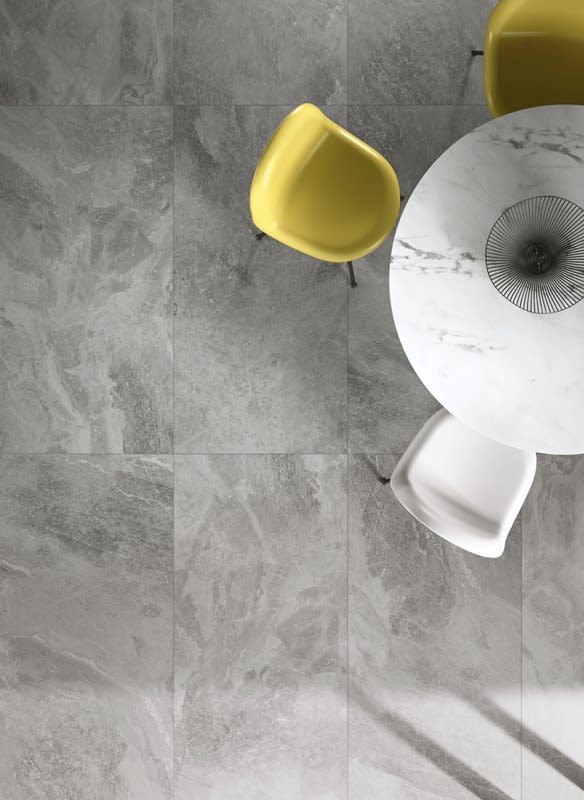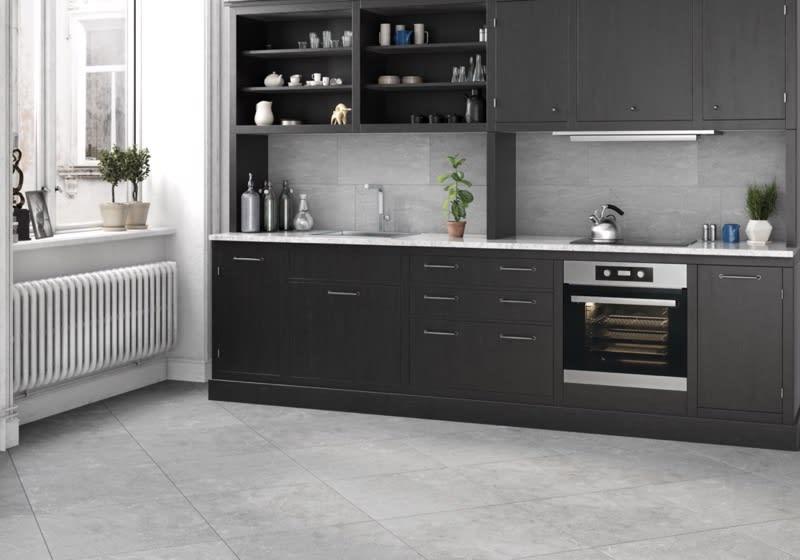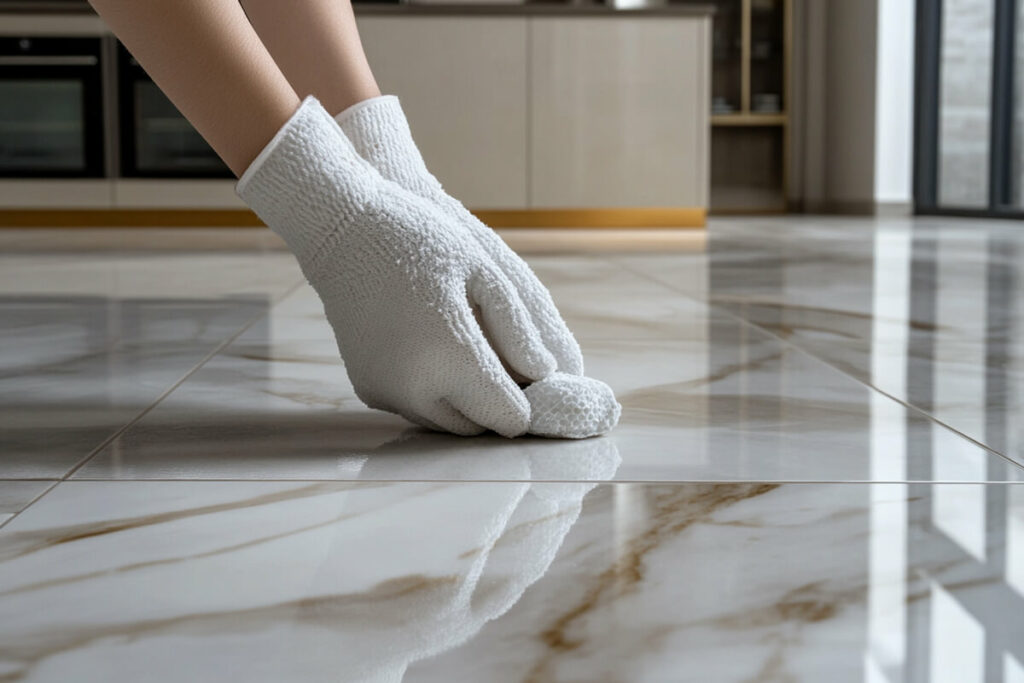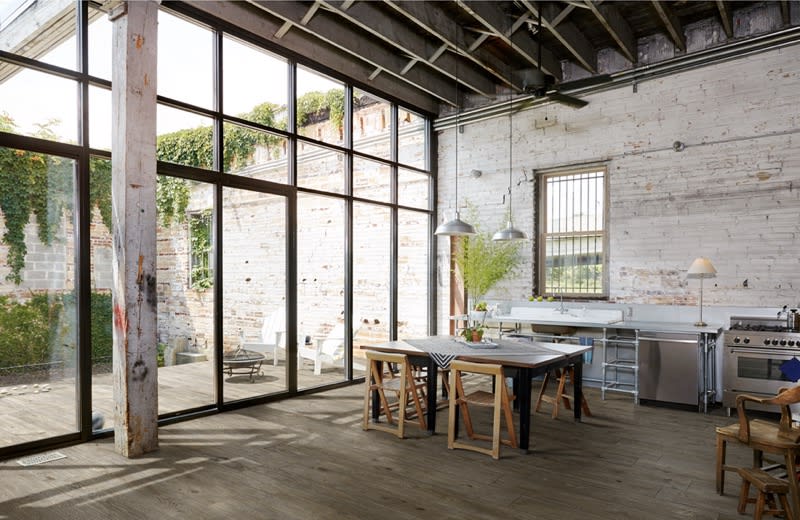Nationwide delivery on most products
Be Inspired with a visit to our showroom
Discount on trade purchases

When it comes to choosing the right kitchen flooring, porcelain and ceramic tiles are often the top options. But the problem is, both materials look great and offer good features, so it’s easy to get confused about which one is better for your kitchen.
You’re probably reading this because you’ve been trying to figure out which tile will work best for you, but the more you look into it, the more overwhelming the decision feels. Maybe you’re concerned about which tile is more durable, or which one will handle the daily messes of a busy kitchen. You might even be wondering if the price difference between porcelain and ceramic tiles is really worth it. Anyway, we completely understand your concerns.
Deciding on the right kitchen flooring can feel like a big decision, especially when you want something that will last and look great for years. That’s why we’re here to make it easier for you to understand the differences between porcelain and ceramic tiles, and help you make the right decision.
The differences we will review:
Both porcelain and ceramic tiles start with the same basic ingredients: clay and minerals. But their production cycle is one of the main reasons what makes them different. Porcelain tiles are made using finer clay, and they’re fired at much higher temperatures compared to ceramic tiles. This process makes porcelain tiles denser and stronger than ceramic tiles.
Because porcelain is less porous, it doesn’t absorb as much water as ceramic. This means porcelain is more durable and can handle heavy foot traffic, which is especially useful in kitchens where people are constantly moving around. The high firing temperature also makes porcelain more resistant to cracking under pressure or heat, so it’s a great option if you’re looking for long-lasting flooring.
On the other hand, ceramic tiles are also strong but not as dense as porcelain. They work well in areas that don’t see as much traffic or moisture, but they might not hold up as well in a busy kitchen environment.
When choosing a tile for your kitchen, the way these tiles are made can have a big impact on how they perform. Porcelain’s higher density makes it more suitable for kitchens where durability and moisture resistance are important.
Now let’s take a closer look at each of these differences.

When it comes to durability, porcelain tiles are the clear winner. Thanks to the way they are made, porcelain is much denser and harder than ceramic. This makes it more resistant to scratches, dents, and general wear and tear. If you plan to build a busy kitchen, porcelain tiles will hold up much better over time. Whether it’s people constantly moving around, heavy furniture, or even the occasional dropped pot or pan, porcelain can handle all of it.
Porcelain’s hardness also means it won’t show signs of damage as easily as ceramic. In fact, it’s tough enough to resist stains and withstand spills from liquids or food, making it a solid choice for a kitchen floor that needs to look good and last a long time.
Ceramic tiles, while still durable, aren’t quite as tough. They work fine in areas that don’t get as much traffic or where moisture isn’t a big concern, like a quiet corner of your kitchen. But in high-use areas, they may show wear more quickly and might need more frequent maintenance to stay in good shape.
If your kitchen sees a lot of daily action, porcelain is the better option for keeping your floors looking great for years to come.

One of the key factors in choosing kitchen flooring is how well it can handle water and stains. It is impossible to avoid spills and humidity in your kitchen. So when it comes to water resistance, porcelain tiles are the better choice. Porcelain has an absorption rate of less than 0.5%, meaning it barely absorbs any water. This makes it highly resistant to damage from water spills, humidity, and even cleaning chemicals.
Ceramic tiles, on the other hand, are more porous than porcelain. Their water absorption rate ranges from 3% to 7%, which means they can take in more water over time. While this isn’t a huge issue in low-moisture areas, it could be a concern in a kitchen where water and spills are common.
Glazes can be applied to ceramic tiles to make them more water-resistant, but even with a glaze, ceramic doesn’t match the water resistance of porcelain. This is especially important in areas like kitchens. The better water resistance of porcelain also means it’s less likely to stain, making it easier to keep clean.
If you want to protect your kitchen floors from water damage and stains, porcelain is the better option, as it provides excellent protection against the mess in the kitchen.

When it comes to maintenance, both porcelain and ceramic tiles are relatively easy to clean, but porcelain tends to require less upkeep in the long run. Porcelain tiles are highly resistant to stains and moisture, so they only need regular sweeping and mopping to stay clean. Because of their dense surface, they don’t absorb liquids, making them easier to maintain without the need for special cleaners or frequent attention. Especially this works amazingly with glazed porcelain tiles.
Ceramic tiles, while still easy to clean, may need more maintenance over time. Some ceramic tiles, especially those with certain decorative finishes, might require sealing to keep them protected. If the ceramic tiles are not sealed or if the glaze wears off, they may absorb water or stains, leading to more frequent resealing.
Porcelain’s durability means you won’t have to worry much about its surface wearing down or needing extra treatment. Overall, porcelain tiles are a lower-maintenance option for kitchens. Ceramic tiles, especially in designs that aren’t fully glazed, might need a bit more care and attention to keep them looking fresh.
When comparing the cost of porcelain and ceramic tiles, it’s important to note that porcelain is typically the more expensive option. The reason for this higher price is the way porcelain is made — it uses finer materials and is fired at higher temperatures, which results in a denser and more durable tile. Because of this, porcelain can cost anywhere from 20% to 50% more than ceramic tiles.
However, that doesn’t mean ceramic tiles aren’t a good option, especially if you’re on a budget. Ceramic tiles are generally more affordable, and you can still get a wide variety of designs and finishes that look great in a kitchen.
In the end, if your budget allows and you want a tile that will last for years with minimal upkeep, porcelain is worth the extra investment. However, if you are low on budget, then you can think about buying ceramic tiles.

When it comes to design flexibility, both porcelain and ceramic tiles offer a wide range of styles, colors, and finishes, making it easy to find something that matches your kitchen’s design. Both materials can be made to mimic other materials like wood, stone, or even concrete, giving you plenty of choices to fit the look you’re going for.
However, porcelain tends to offer more realistic finishes, especially when it comes to mimicking natural materials like stone or wood. The higher density and finer materials used in porcelain allow for more detailed textures and patterns, which can give your kitchen floor a more authentic look. This makes porcelain a great choice if you’re looking for tiles that successfully replicate the natural stone effect or wood effect without the high cost or maintenance of those materials.
Ceramic tiles also come in various designs, but they may not achieve the same level of detail and realism as porcelain. That being said, ceramic is still a versatile option if you’re working within a specific design budget and don’t need that extra level of detail.
In terms of modern trends, large format porcelain tiles have become especially popular. These bigger tiles create a seamless look with fewer grout lines, making your kitchen appear more spacious and clean. Porcelain’s durability also means that large tiles can cover bigger areas without the risk of cracking. If you’re looking for a sleek, modern kitchen design, large format porcelain tiles are an excellent option to consider.
Overall, both porcelain and ceramic tiles offer a wide variety of styles to choose from, but porcelain gives you a more realistic, high-end look that can really elevate your kitchen’s design.
Porcelain tiles are excellent if you’re looking for long-lasting strength, realistic finishes, and low upkeep. However, if you are low on budget and saving money is your priority, then look for ceramic tiles, as they are still a good solution for a kitchen.
If there are still any questions regarding indoor tiles or would like to request a free sample, we welcome you to contact us or visit one of our depots.
© 2024 Natural Stone & Timber Ltd. All rights reserved. Privacy Policy Terms & Conditions | Website Designed & Built by Zest Digital
Please set your location to see prices.
Set your location